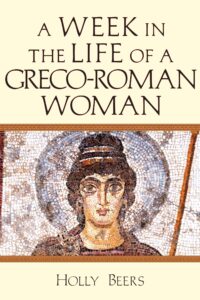 At first glance, this book may seem to be an odd choice for review. However, this title is actually part of a series by InterVarsity Press that explores, in novella format, various aspects of life in the New Testament world. Other titles in the series include A Week in the Life of a Roman Centurion (G. Burge), A Week in the Life of Corinth (B. Witherington III), A Week in the Fall of Jerusalem (B. Witherington III), A Week in the Life of Rome (J. Papandrea), A Week in the Life of a Slave (J. Byron), and A Week in the Life of Ephesus (D. deSilva). Each book is divided into seven chapters that represent—wait for it—each day of the week.
At first glance, this book may seem to be an odd choice for review. However, this title is actually part of a series by InterVarsity Press that explores, in novella format, various aspects of life in the New Testament world. Other titles in the series include A Week in the Life of a Roman Centurion (G. Burge), A Week in the Life of Corinth (B. Witherington III), A Week in the Fall of Jerusalem (B. Witherington III), A Week in the Life of Rome (J. Papandrea), A Week in the Life of a Slave (J. Byron), and A Week in the Life of Ephesus (D. deSilva). Each book is divided into seven chapters that represent—wait for it—each day of the week.
These books are quick yet engaging reads. Though the main storyline is a fictionalized, hypothetical reconstruction, numerous little sidebars of factual information shed light on various aspects of the Biblical text. For example, the author provides outtakes on such things as “Food,” “Urban Housing,” and “Honor and Shame.”
A Week in the Life of a Greco-Roman Woman is set in Ephesus during the days of Paul’s ministry there, as recorded in Acts. Paul is not the main character, yet he makes occasional appearances in the narrative. The storyline plausibly envisions what it may have been like for certain women of Ephesus to come to hear and believe the gospel as preached by Paul and to enter into the communion of the small group of believers. The author, I feel, presents in a believable manner the thoughts that those breaking away from their pagan roots might have had—the fears, the misgivings, the excitement, etc. To provide somewhat of a timestamp, this book’s “week” references the people of Ephesus burning their scrolls of magic, but the narrative breaks off prior to the riot of the silversmiths.
There may be mixed opinions about publishers creating something akin to modern Christian “midrash”—these somewhat speculative historical reconstructions based on Biblical texts. For my part, the most valuable features of these texts are the little contextual sidebars mentioned above. Yet I can also see God’s people enjoying and benefitting from reading this book and others in the series. I tentatively suggest that they could even be the basis for a congregational midweek Bible class. Ultimately, these texts aren’t any different from other books of reconstructed New Testament history enjoyed by Christians over the past century, whether that be Sienkiewicz’s Quo Vadis?, Wallace’s Ben-Hur, or Maier’s The Flames of Rome, Pontius Pilate, and A Skeleton in God’s Closet.

